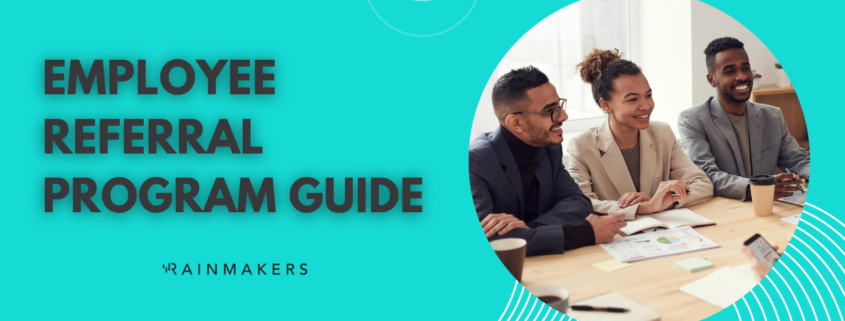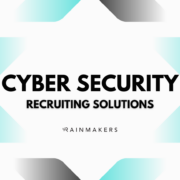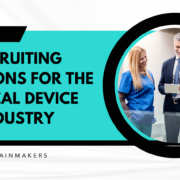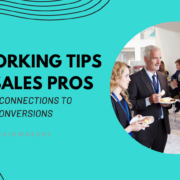How To Attract Top Talent With A Referral Program
Using An Employee Referral Program Effectively
In this guide, we’ll break down 11 steps to build a killer employee referral program to help you attract top talent. Read on!
Businesses will do everything in their power to attract competent professionals and use every trick in the book to strengthen their talent pool. Traditionally, HR solely assumed responsibility for this function, but as new technologies, mindsets, and practices (such as crowdsourcing and user-generated content) recast the workplace, more unique and more responsive methods for recruiting talent emerge.
In recent years, Employee Referral Programs (ERP) have become a competitive advantage in the talent-sourcing market. According to reports, it has surpassed conventional talent acquisition and recruitment practices as the top method for finding and hiring new employees.
What is an Employee Referral Program?
An employee referral program is an in-house system for finding, qualifying, and hiring candidates for vacant roles and functions in the company. ERPs incentivize employees to submit personal referrals from their social and professional networks who may qualify for open positions in the company. Incentives and rewards may include monetary bonuses and non-monetary prizes such as vacations and concert tickets.

Benefits of Employee Referral Programs
Numerous studies have already established the case for ERPs. Here are some of the most persuasive arguments for its adoption:
- Employee referral programs significantly reduce recruitment costs, with a study finding that businesses can save $3000 or more per hire using referrals.
- ERPs improve candidate quality, culture fit, and retention rate.
- Candidates sourced via an employee referral program get hired much faster than candidates sourced through traditional channels.
- Candidates sourced via ERP make it to onboarding stage (3 to 4 times) more compared to candidates sourced via traditional methods
- ERP-sourced candidates deliver the highest ROI compared to other methods.
And here are some figures from LinkedIn:
- Employee referrals rank as the number 1 method for people to discover a new job.
- Companies can expand their talent pool by as much as ten times if they leverage their employees’ social and professional networks via an effective referral program.
- While rewards motivate employees to submit referrals, 35% do so primarily to help friends, 32% to help their organization, and 26% to be recognized as a valuable colleague. Only 6% submit referrals for the rewards.
- Candidates are 46% more likely to accept your messages when these messages are associated or tagged with employees they personally know.
- Along with online job boards and social media, employee referral programs are among the top source of high-quality talent.
11 Steps To Turbo-Charge Your Employee Referral Program
1) Set clear objectives.
Only embark on a journey with a clear destination in mind. Ideal employee referral programs go beyond getting as many candidates as possible in your talent pool. While across-the-board recruitment is obviously the overarching goal of ERPs, you can still fine-tune the program for specific campaign-based objectives such as improving workforce diversity, populating a freshly minted customer success unit, or expediting the search for a crucial software developer position specializing in a particular programming language or development framework.
Once specific objectives have been set for time-bound referral campaigns, get the entire organization in the loop. Communicate the goals, explain the need, and mention the rewards. Again, transparency, immediacy, and relevance will help drive and sustain employee involvement.

2) Make everything simple and easy.
Even when employees want to participate in your ERP, engagement and results will ultimately depend on how simple and effective your referral process is. Conversely, tedious, convoluted, and inconsistent ERP processes may generate buzz at the onset but tend to fizzle out much sooner than everyone expected.
Never complicate the process. Don’t require employees and referred candidates to exert more effort than is necessary. Remember, your people have primary functions they need to focus on. An ERP solution that requires too much time and effort will keep them from delivering high performance in the roles they were hired for in the first place. So make it ridiculously easy to attract, submit, monitor, evaluate, and conclude referrals.
One way is to adopt ERP and applicant tracking solutions (ATS) that are intuitive, easily accessible, and engaging. Go for mobile-ready packages that are integrable to networks such as LinkedIn, Twitter, and Facebook. Embrace solutions that virtually anyone in the company can access anytime and enjoy using.
3) Let everyone know.
You might have the best ERP, but nothing happens if no one knows about it. Communication is the glue that keeps effective referral programs together. ERP awareness and involvement should pervade the organization from top to bottom and from the ground up. Make it everyone’s business to find and attract talent because it is the only resource to make things happen.
Advertise your referral program and bang the gong each time you launch specific referral campaigns. (Some companies even go beyond the organization to include customers, suppliers, and vendors in their incentives program). Information about vacancies, job requirements, role qualifications, corporate culture, benefits, candidate status, incentives for efforts, and successful referral rewards should be easily accessible.
Establish a communication, feedback, and tracking system that keeps all stakeholders in the loop and enables them to advance referrals from start to finish easily. Form a team or assign a coordinator to ensure ERP communications are clear, complete, and pervasive.
4) Use technology.
In virtually every aspect of business, technology serves as the ultimate enabler. However, the way technology is used can also make a big difference. The baseline is to have a centralized ERP platform that makes it extremely easy for employees to submit referrals, for HR to evaluate candidates, for referred candidates to track their status, and for everyone in the loop to communicate.
Some applicant tracking systems (ATS) have native ERP functionalities, while others allow for equivalent plugins or extensions. Determine what is best for your organization. In the new economy, relying on mere emails or spreadsheets to manage referrals and talent acquisition will no longer make the cut.

5) Train your people.
The processes and technologies that comprise your employee referral program may be intuitive. However, it would be best if you still educated everyone about more innovative ways to use the system and the rationale and rewards behind the program.
Articulate the program’s overall goal of attracting competent — if not top-notch — professionals to the company. Establish quality benchmarks. Because candidate screening takes time, dissuade employees from referring known shenanigans at the onset.
Walk everyone through the process from start to finish, so they know what to expect regarding feedback frequency, documentary requirements, and screening parameters. Finally, clarify how incentives and rewards will be implemented.
6) Speed up the process.
Few things are more frustrating than having to wait longer than you should. Employees who were initially excited to a) help friends get onboard, b) help the company solve its talent shortage, or c) help themselves to the ERP’s excellent incentives will eventually lose steam when left to keep wondering whatever happened to their referrals.
Establish a reasonable timeline for processing employee referrals. Always send timely feedback each time a milestone has been reached. Respond to employee or candidate queries and clarifications within 24 hours.
Consider screening and interviewing candidates within one week before giving a job offer or terminating their candidacy for the specific role they were referred to. One way to do this is to provide remote interview and assessment options.
7) Provide an excellent candidate experience.
Make your brand as an employer stand out. Start by giving job applicants a smooth, flexible, responsive, and stress-free experience. This way, candidates who don’t get on board will still remember the good experience and share it with their friends. Remember, online reputation matters.
8) Recognize efforts, and reward results.
Without motivation, people will hardly move. Sure, helping friends land a job or being loyal to a good company may incentivize employees to submit referrals, but that won’t be enough to sustain an ambitious talent acquisition strategy. People exert effort because they expect something out of it.
That being said, rewards entail costs, and a good employee referral program should have a well-thought-out budget and reward strategy. The key is to have compelling but sustainable rewards for good results and adequate incentives for keeping employees involved in the ERP.
Having creative, unique, or original rewards will go a long way. In addition to monetary prizes, you should also consider vacations, gadgets, free enrollment to a popular certifications program, and tickets to concerts, sporting events, or health spas. Acknowledge and incentivize active ERP participants even when their referrals are not hired. You can, for example, use a point-based gamification system that entitles active ERP participants to free breaks and treats at the nearest cafe.
Bottomline: make your rewards and incentives system so fun, compelling, and sustainable that employees will enjoy being involved in ERP for the long haul.
9) Try every method. Explore all channels.
There are countless ways to implement an employee referral program. However, you’ll limit your talent acquisition potential if you keep yourself from trying more than a few. Worse, you may not discover what works perfectly for your organization if you adopt the same methods repeatedly.
Some of the techniques used by smart talent acquisition teams include the following —
- Gamification of incentives to sustain employee engagement
- Linking ERP with performance assessments
- Referral sprints (extremely short but focused campaigns to create a shortlist of candidates)
- Quarterly referral contests (most referrals, most successful hires, funniest candidates, etc.) between groups, teams, or departments with significant rewards to the ultimate winner
- Head-turning rewards such as cars, home entertainment systems, and exotic travel packages to be awarded during special company events.
10) Make onboarding memorable.
Greet new hires via the referral program with a warm welcome. This extends their great experience during the recruiting process and reinforces the impression that your company truly values its talent. Provide relevant training and responsive coaching that will prepare new hires for the specific challenges associated with their functions and immerse them in the corporate culture.
Make a case for your brand throughout the employee journey. Make new hires feel at home and happy about joining your company so they’ll gladly participate in the referral program immediately.
11) Assess program performance. Improve. Repeat.
A functioning employee referral program that reels decent talent from the job market is terrific. But that is not enough. You always have to think long-term and consider emerging changes in the workplace. That entails making a self-assessment on whether the ERP is as successful as it can possibly be.
Establish your criteria for success. These could be metrics such as —
- Employee Engagement (percentage of employees participating in the ERP)
- Share of Referrals to the Number of Total Hires per Period
- Percentage of Good Referrals to Total Number of Referrals
- Performance of Employees Hired via ERP
Use other data-driven metrics to measure the success of your ERP implementation. When results do not meet your expectations, adopt other techniques, approaches, and technologies that may improve performance.
Reboot. Repeat.
Conclusion
Whether you are just starting to build an employee referral program or have been running one for a while, getting the results you expect don’t happen automatically. You may use the best HR technologies on the market but cannot automate success.
Talent is about humans, and recruiting talent into your company takes a team of motivated humans on the other side of the equation. By making your company a stakeholder in talent acquisition, you give everyone a proactive role in your company’s success.
Valuing people is the first step in strengthening an employer’s brand. If your brand sticks, your employees will more than gladly submit candidate referrals to a company they are proud of.
Need help getting started? Contact the team at Rainmakers to help with your recruiting efforts!












